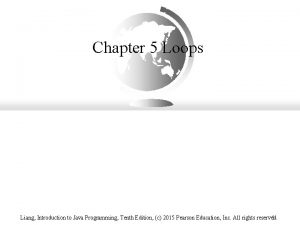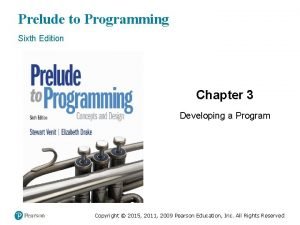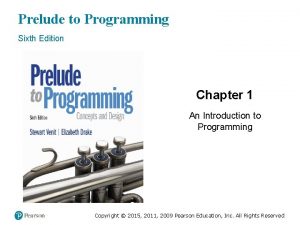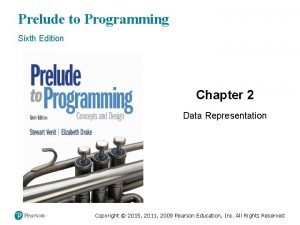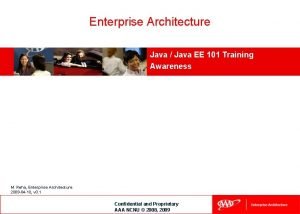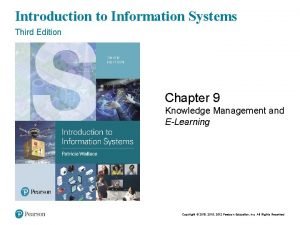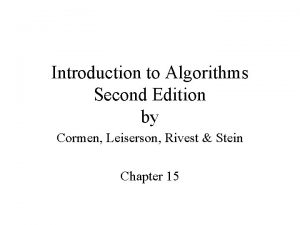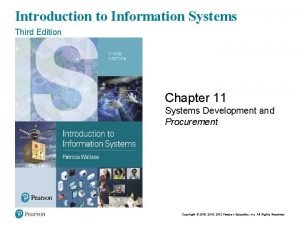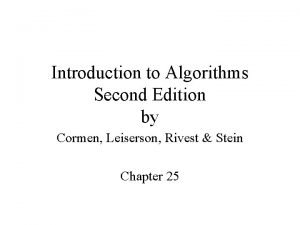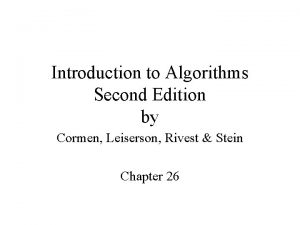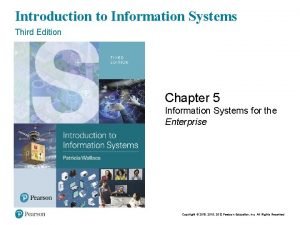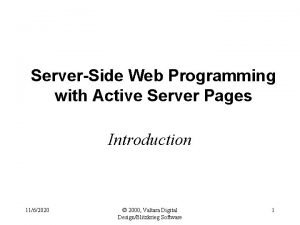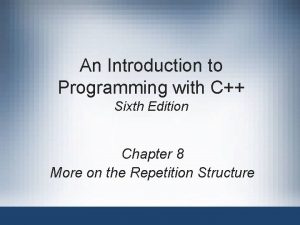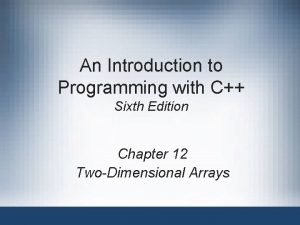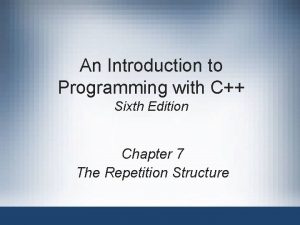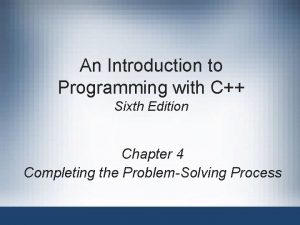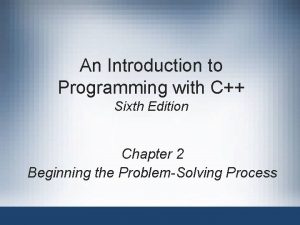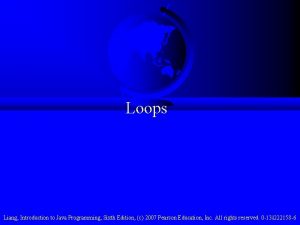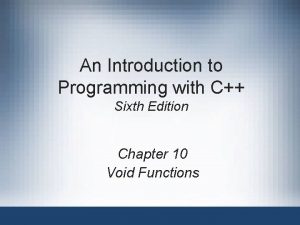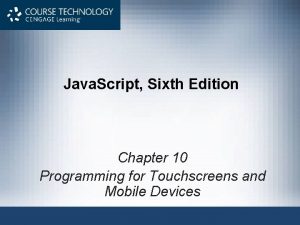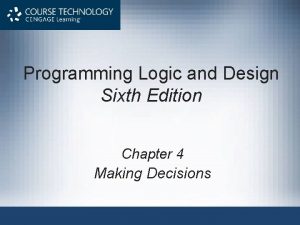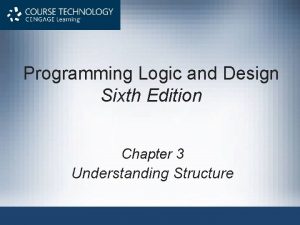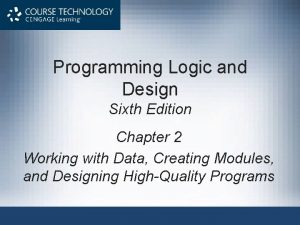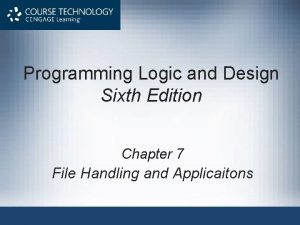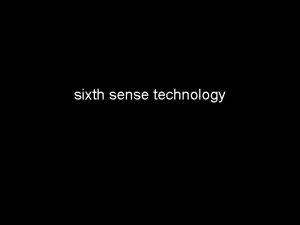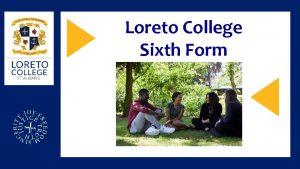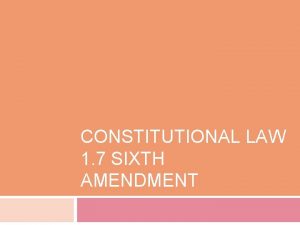An Introduction to Programming with C Sixth Edition











































- Slides: 43

An Introduction to Programming with C++ Sixth Edition Chapter 3 Variables and Constants

Objectives • Distinguish among a variable, named constant, and literal constant • Explain how data is stored in memory • Select an appropriate name, data type, and initial value for a memory location • Declare a memory location in C++ An Introduction to Programming with C++, Sixth Edition 2

Beginning Step 4 in the Problem. Solving Process • After Step 3, programmer has an algorithm and has desk-checked it • Fourth step in the process is coding the algorithm into a program • Step begins by assigning a descriptive name, data type, and (optionally) initial value to each unique input, processing, and output item in the IPO chart • These are used to store the item in the computer’s internal memory An Introduction to Programming with C++, Sixth Edition 3

Internal Memory • Computer’s internal memory is composed of memory locations, each with a unique numeric address • Similar to collection of storage bins • Each address can store one item at a time • Address can contain numbers, text, or program instructions • To use a memory location, programmer must reserve the address, called declaring An Introduction to Programming with C++, Sixth Edition 4

Internal Memory (cont’d. ) • Declaring a memory location is done with an instruction that assigns a name, data type, and (optional) initial value • The name allows the programmer to refer to the memory location elsewhere in the program using a descriptive word, rather than the numeric address • The data type indicates what type of information the address will store (e. g. , number or text) An Introduction to Programming with C++, Sixth Edition 5

Internal Memory (cont’d. ) • Two types of memory locations can be declared: variables and named constants • Variables are memory locations whose values can change during runtime (when the program is running) • Most memory locations are variables • Named constants are memory locations whose values cannot change An Introduction to Programming with C++, Sixth Edition 6

Internal Memory (cont’d. ) Figure 3 -1 Illustration of storage bins An Introduction to Programming with C++, Sixth Edition 7

Selecting a Name for a Memory Location • Name (identifier) assigned to a memory location should be descriptive • Should help the programmer/other programmers remember/understand the memory location’s purpose • Should be as short as possible while still being descriptive (especially if referenced often) • Short names are easier to read and result in more concise code An Introduction to Programming with C++, Sixth Edition 8

Selecting a Name for a Memory Location (cont’d. ) • Rules for memory location names in C++ – Name must begin with a letter and contain only letters, numbers, and the underscore character – No punctuation marks, spaces, or other special characters (such as $ or %) are allowed – Cannot be a keyword (word that has special meaning in C++) – Names are case sensitive • Example: discount is different from DISCOUNT and from Discount An Introduction to Programming with C++, Sixth Edition 9

Selecting a Name for a Memory Location (cont’d. ) • Most programmers use uppercase letters for named constants and lowercase for variables – Example: PI (constant), radius (variable) • If constants contain more than one word, separate words with underscores – Example: TAX_RATE • If variables contain more than one word, capitalize the first letter of each word after the first (called camel case) – Example: adjusted. Gross. Income An Introduction to Programming with C++, Sixth Edition 10

Figure 3 -2 How to name a memory location in C++ An Introduction to Programming with C++, Sixth Edition 11

Revisiting the Treyson Mobley Problem Figure 3 -3 Problem specification, IPO chart, and desk-check table from Chapter 2 An Introduction to Programming with C++, Sixth Edition 12

Revisiting the Treyson Mobley Problem (cont’d. ) • IPO chart contains five input, processing, and output items • Five memory locations are needed to store the values of the items • Memory locations will be variables since their values will change during runtime An Introduction to Programming with C++, Sixth Edition 13

Revisiting the Treyson Mobley Problem (cont’d. ) Figure 3 -4 Names of the variables for the Treyson Mobley problem An Introduction to Programming with C++, Sixth Edition 14

Selecting a Data Type for a Memory Location • Memory locations come in different types and sizes • Type and size you choose depends on the item you want to store • A memory location will only accept an item that matches its data type • Data type of a memory location is determined by the programmer when declaring the location An Introduction to Programming with C++, Sixth Edition 15

Selecting a Data Type for a Memory Location (cont’d. ) • Fundamental data types are basic data types built into C++ – Also called primitive or built-in data types – Include short, int, float, double, bool, and char • bool data type stores Boolean values (true and false) • short and int types store integers (numbers without a decimal place) – Differences are range of values and memory used (int has the greater of both) An Introduction to Programming with C++, Sixth Edition 16

Selecting a Data Type for a Memory Location (cont’d. ) • float and double types store real numbers (numbers with a decimal place) – Differences are range of values, precision, and memory used (double has the greater of each) • char type stores characters (letter, symbol, or number that will not be used in a calculation) – Only one character stored at a time • string data type is a user-defined data type (defined with a class, or group of instructions) – Can store zero or more characters An Introduction to Programming with C++, Sixth Edition 17

Selecting a Data Type for a Memory Location (cont’d. ) Figure 3 -5 Most commonly used data types in C++ An Introduction to Programming with C++, Sixth Edition 18

Selecting a Data Type for a Memory Location (cont’d. ) Figure 3 -6 Data type assigned to each variable for the Treyson Mobley problem An Introduction to Programming with C++, Sixth Edition 19

How Data Is Stored in Internal Memory • Numbers represented in internal memory using binary (base 2) number system (two digits, 0 and 1) • We are used to the decimal (base 10) number system (ten digits, 0 through 9) • Character data is stored using ASCII codes – Eight-bit codes (bit = binary digit, 0 or 1) – Upper and lowercase versions of letters have distinct codes • Computer distinguishes between numbers and ASCII codes based on data type An Introduction to Programming with C++, Sixth Edition 20

How Data Is Stored in Internal Memory (cont’d. ) Figure 3 -7 How to use the decimal (base 10) number system An Introduction to Programming with C++, Sixth Edition 21

How Data Is Stored in Internal Memory (cont’d. ) Figure 3 -8 How to use the binary (base 2) number system An Introduction to Programming with C++, Sixth Edition 22

Figure 3 -9 Partial ASCII chart An Introduction to Programming with C++, Sixth Edition 23

Selecting an Initial Value for a Memory Location • Setting an initial value for a variable or named constant is called initializing • Required for constants; recommended for variables • Memory locations are usually initialized with a literal constant (item of data that can appear in a program instruction and be stored in memory) • Data type of literal constant should match data type of memory location it is assigned to An Introduction to Programming with C++, Sixth Edition 24

Selecting an Initial Value for a Memory Location (cont’d. ) • Numeric literal constants initialize short, int, float, and double data types – Can contain digits 0 through 9, +, -, . , and e or E (for scientific notation) • Character literal constants initialize char data types – Consist of one character in single quotation marks • String literal constants initialize string data types – Zero or more characters enclosed in double quotation marks – Empty string (“”) is a valid string literal constant An Introduction to Programming with C++, Sixth Edition 25

Selecting an Initial Value for a Memory Location (cont’d. ) • Before assigning initial value to a memory location, computer checks that value’s data type matches location’s data type • If they don’t match, computer performs implicit type conversion to match them – If initial value is converted to type that holds larger numbers, value is promoted – If initial value is converted to type that only holds smaller numbers, value is demoted • Promoting will not usually have adverse effects, but demoting can (information is lost) An Introduction to Programming with C++, Sixth Edition 26

Selecting an Initial Value for a Memory Location (cont’d. ) • Important to initialize memory locations with values of the same data type • Named constants should be initialized with the value they will hold for the duration of the program • Variables whose initial values are not known should still be initialized – – short and int types usually initialized to 0 float and double types usually initialized to 0. 0 string types usually initialized to empty string (“”) bool types initialized to either true or false An Introduction to Programming with C++, Sixth Edition 27

Selecting an Initial Value for a Memory Location (cont’d. ) Figure 3 -10 Initial values for the variables in the Treyson Mobley problem An Introduction to Programming with C++, Sixth Edition 28

Declaring a Memory Location • Variables and named constants are declared using a statement (C++ instruction) • A statement that declares a variable causes the computer to set aside a memory location with the given name, data type, and initial value • Statements must follow correct syntax (rules of a programming language) • In C++, all statements must end with a semicolon An Introduction to Programming with C++, Sixth Edition 29

Declaring a Memory Location (cont’d. ) • When declaring variables, a data type and name must be provided • Syntax for declaring a variable in C++ – data. Type variable. Name [= initial. Value]; • After variable is declared, you use its name to refer to it later in the program • Initial value is optional but recommended • If variable is not initialized, it contains the previous value of that memory location, which may be the wrong type (called a garbage value) An Introduction to Programming with C++, Sixth Edition 30

Declaring a Memory Location (cont’d. ) • Syntax for declaring a named constant in C++ – const data. Type constant. Name = value; • const keyword indicates that the memory location is a named constant (value cannot be changed during runtime) • Initial value required for constants, unlike variables • As with variables, after declaring a constant, you can use its name to refer to it later in the program An Introduction to Programming with C++, Sixth Edition 31

Declaring a Memory Location (cont’d. ) • Several advantages to using named constants when appropriate – Make program more self-documenting (meaningful words in place of numbers) – Value cannot be inadvertently changed during runtime – Typing a name is less error-prone than a long number – Mistyping a constant’s name will trigger a compiler error; mistyping a number will not – If the constant needs to be changed when modifying the program, it only needs to be changed in one place An Introduction to Programming with C++, Sixth Edition 32

Declaring a Memory Location (cont’d. ) Figure 3 -11 How to declare a variable in C++ An Introduction to Programming with C++, Sixth Edition 33

Declaring a Memory Location (cont’d. ) Figure 3 -12 C++ declaration statements for the variables in the Treyson Mobley problem An Introduction to Programming with C++, Sixth Edition 34

Declaring a Memory Location (cont’d. ) Figure 3 -13 How to declare a named constant in C++ An Introduction to Programming with C++, Sixth Edition 35

Summary • Fourth step in problem-solving process is coding the algorithm • Memory location is declared for each input, processing, and output item in IPO chart • Numeric data is stored in computer’s internal memory using binary number system • Memory locations store one item at a time • Memory location’s data type determines how a value is stored and interpreted when retrieved An Introduction to Programming with C++, Sixth Edition 36

Summary (cont’d. ) • Two types of memory locations: variables and named constants • Memory locations are declared using a statement that assigns a name, data type, and initial value • Initial value required for named constants but optional for variables (though recommended) • Most memory locations initialized with literal constants, except bool (initialized with keywords true or false) An Introduction to Programming with C++, Sixth Edition 37

Summary (cont’d. ) • Data type of literal constant assigned to memory location should be same as memory location’s type • If types don’t match, implicit type conversion is used to either promote or demote so they match • Promoting doesn’t usually cause problems, but demoting can • Syntax for declaring variables – data. Type variable. Name [= initial. Value]; • Syntax for declaring named constants – const data. Type constant. Name = value; An Introduction to Programming with C++, Sixth Edition 38

Lab 3 -1: Stop and Analyze Figure 3 -14 Problem specification, IPO chart, and desk-check table for Lab 3 -1 An Introduction to Programming with C++, Sixth Edition 39

Lab 3 -2: Plan and Create Figure 3 -15 Problem specification for Lab 3 -2 An Introduction to Programming with C++, Sixth Edition 40

Lab 3 -3: Modify • Modify the IPO chart in Figure 3 -17 so that it includes the radius squared as a processing item Figure 3 -17 Completed IPO chart for Lab 3 -2 An Introduction to Programming with C++, Sixth Edition 41

Lab 3 -4: Desk-Check • Using the IPO chart modified in Lab 3 -3, modify the manual calculations and desk-check tables shown in Figures 3 -18 and 3 -19 Figure 3 -18 Manual area calculations for the two desk-checks Figure 3 -19 Completed desk-check table for Lab 3 -2 An Introduction to Programming with C++, Sixth Edition 42

Lab 3 -5: Debug • Correct the C++ instructions shown in Figure 3 -21 – The memory locations will store real numbers • Find and correct the errors in the algorithm Figure 3 -21 IPO chart information and C++ instructions for Lab 3 -5 An Introduction to Programming with C++, Sixth Edition 43
 Peter pickle tongue twister
Peter pickle tongue twister The sixth sick sheik's sixth sheep's sick lyrics
The sixth sick sheik's sixth sheep's sick lyrics Introduction to java programming 10th edition quizzes
Introduction to java programming 10th edition quizzes Biochemistry sixth edition 2007 w.h. freeman and company
Biochemistry sixth edition 2007 w.h. freeman and company Computer architecture a quantitative approach sixth edition
Computer architecture a quantitative approach sixth edition Automotive technology sixth edition
Automotive technology sixth edition Automotive technology sixth edition
Automotive technology sixth edition Apa sixth edition
Apa sixth edition Computer architecture a quantitative approach sixth edition
Computer architecture a quantitative approach sixth edition Precalculus sixth edition
Precalculus sixth edition Principles of economics sixth edition
Principles of economics sixth edition Computer architecture a quantitative approach sixth edition
Computer architecture a quantitative approach sixth edition Using mis 10th edition
Using mis 10th edition Report
Report Prelude to programming 6th edition
Prelude to programming 6th edition Prelude to programming 6th edition
Prelude to programming 6th edition Prelude to programming 6th edition
Prelude to programming 6th edition Java enterprise architecture
Java enterprise architecture Expert systems: principles and programming, fourth edition
Expert systems: principles and programming, fourth edition Perbedaan linear programming dan integer programming
Perbedaan linear programming dan integer programming Greedy vs dynamic
Greedy vs dynamic System programming vs application programming
System programming vs application programming Integer programming vs linear programming
Integer programming vs linear programming Perbedaan linear programming dan integer programming
Perbedaan linear programming dan integer programming Marketing an introduction 6th canadian edition
Marketing an introduction 6th canadian edition Introduction to teaching becoming a professional
Introduction to teaching becoming a professional Introduction to sociology 9th edition
Introduction to sociology 9th edition Introduction to radar systems skolnik 3rd edition pdf
Introduction to radar systems skolnik 3rd edition pdf Introduction to information systems 6th edition
Introduction to information systems 6th edition Introduction to information systems 6th edition
Introduction to information systems 6th edition Microbiology an introduction 9th edition
Microbiology an introduction 9th edition Introduction to information systems 3rd edition
Introduction to information systems 3rd edition Introduction to information systems 5th edition
Introduction to information systems 5th edition Food and beverage directors expect a pour cost of
Food and beverage directors expect a pour cost of Introduction to hospitality 7th edition
Introduction to hospitality 7th edition Introduction to hospitality 7th edition
Introduction to hospitality 7th edition Introduction to algorithms 2nd edition
Introduction to algorithms 2nd edition Introduction to information systems 3rd edition
Introduction to information systems 3rd edition Introduction to algorithms 2nd edition
Introduction to algorithms 2nd edition Introduction to algorithms 2nd edition
Introduction to algorithms 2nd edition Human genetics concepts and applications 10th edition
Human genetics concepts and applications 10th edition Kinicki: management: a practical introduction 3rd edition
Kinicki: management: a practical introduction 3rd edition Introduction to information systems 3rd edition
Introduction to information systems 3rd edition Introduction to server side programming
Introduction to server side programming


